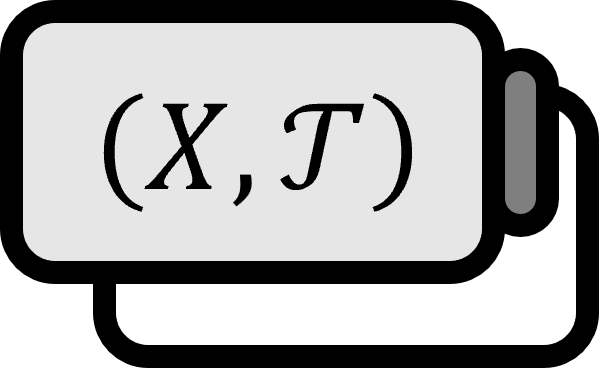Cartesian Product of Topological Spaces
Definition 1
For an index set $\mathscr{A}$, let $\left\{ X_{\alpha} \ | \ \alpha \in \mathscr{A} \right\}$ be a set of topological spaces, and let $O_{\alpha}$ be an open set in $X_{\alpha}$.
- For the Cartesian product $\displaystyle X := \prod_{\alpha \in \mathscr{A}} X_{ \alpha}$, $p_{\alpha} : X \to X_{\alpha}$ is called the projection.
- The topology generated by a subbasis $\mathscr{S} : = \left\{ p_{\alpha}^{-1} ( O_{\alpha} ) \ | \ O_{\alpha} \subset X_{\alpha} , \alpha \in \mathscr{A} \right\}$ for $X$ is called the product topology.
- The topology generated by a basis $\displaystyle \mathscr{B} : = \left\{ \prod_{\alpha \in \mathscr{A}} O_{\alpha} \left. \ \right| \ O_{\alpha} \subset X_{\alpha} , \alpha \in \mathscr{A} \right\}$ for $X$ is called the box topology.
Theorem
- [1]: $p_{\alpha}$ is a continuous function.
- [2]: If $\left\{ X_{\alpha} \ | \ \alpha \in \mathscr{A} \right\}$ is a set of Hausdorff spaces, then $X$ is Hausdorff.
- [3]: If $\left\{ X_{\alpha} \ | \ \alpha \in \mathscr{A} \right\}$ is a set of connected spaces, then $X$ is connected.
- [4]: If $\left\{ X_{\alpha} \ | \ \alpha \in \mathscr{A} \right\}$ is a set of compact spaces, then $X$ is compact.
Let $\mathscr{A} = \mathbb{N}$.
- [5]: If $\left\{ X_{\alpha} \ | \ \alpha \in \mathscr{A} \right\}$ is a set of separable spaces, then $X$ is separable.
- [6]: If $\left\{ X_{\alpha} \ | \ \alpha \in \mathscr{A} \right\}$ is a set of first-countable spaces, then $X$ is first-countable.
- [7]: If $\left\{ X_{\alpha} \ | \ \alpha \in \mathscr{A} \right\}$ is a set of second-countable spaces, then $X$ is second-countable.
- [8]: If $\mathscr{A}$ is a finite set, then the product topology and box topology of $X$ are the same.
Explanation
The reason why a complicated subbasis appears in the definition is mainly for the use of intersections, as the definition of basis does not allow anything other than unions.
According to the definition of subbasis, the basis that is generated for the product topology by the subbasis $\mathscr{S}$ is $$ \left\{ \left. \bigcap_{i=1}^{n} p_{\alpha_{i} }^{-1} ( O_{ \alpha_{i} } ) \ \right| \ p_{\alpha_{i} }^{-1} ( O_{ \alpha_{i} } ) \in \mathscr{S} \right\} $$. Naturally, for the basis of the box topology $\mathscr{B}$, $$ \left\{ \left. \bigcap_{i=1}^{n} p_{\alpha_{i} }^{-1} ( O_{ \alpha_{i} } ) \ \right| \ p_{\alpha_{i} }^{-1} ( O_{ \alpha_{i} } ) \in \mathscr{S} \right\} \subset \mathscr{B} $$ holds. The fact that the elements of the box topology include those generated from the subbasis of the product topology means that the box topology has the same or more elements than the product topology, and thus the product topology is referred to as being smaller, coarser, or weaker.
The fact that theorem [8] holds is surprisingly rare. Remembering the fact ’the box contains the product’ helps in avoiding confusion. The fact that it touches upon dimensions not just finite or countably infinite, but arbitrary dimensions, is somewhat shocking.
Topology for Non-Majors
However, considering Cartesian products in topology is more interesting than any other field, whether it’s due to generalization over dimensions or multivariate analysis. But now, it feels closer to the popularly known topology.
Consider the following spaces for $I := [0,1]$ and $S^{1} = \left\{ (x,y) \in \mathbb{R}^2 \ | \ x^2 + y^2 =1 \right\}$.
 From left to right, a square $I \times I$, a cylinder $I \times S^{1}$, and a torus $S^{1} \times S^{1}$.
From left to right, a square $I \times I$, a cylinder $I \times S^{1}$, and a torus $S^{1} \times S^{1}$.
Starting from one-point compactification, it has now become a kind of mathematics that gives a feeling of spaces being twisted and folded.
See Also
Munkres. (2000). Topology(2nd Edition): p113~114. ↩︎
